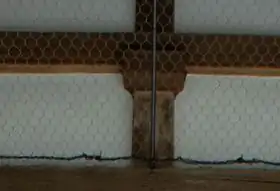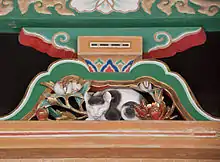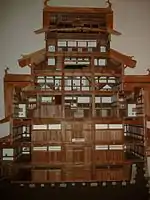


Nakazonae (中備・中具) is a Japanese classification of several intercolumnar struts of different origin installed in the intervals between bracket complexes (tokyō) at wooden architectures in East Asia.[1]
In origin they were necessary to help support the roof; however, at the end of the 10th century the invention of the hidden roof[note 1] made them superfluous.[2] They remained in use, albeit in a purely decorative role, and are typical of the Wayō style. The Zenshūyō style used by Zen temples has instead bracket complexes even between posts.
Shuzhu or Kentozuka
The simplest of these struts are the kentozuka (間斗束, lit. interval block strut, see photo above) composed of a short post and a bearing block.[3]
Minozuka
Similar to the kentozuka is the fan-shaped strut called minozuka (蓑束, lit. straw raincoat strut) (see gallery), which can have decorations on the two sides called 笈形 (oigata) or a collar-like decoration between post and bearing block. The name comes from its shape, similar to that of a traditional straw raincoat called mino.[4]
Hana-hijiki
A variant of the hijiki (肘木) or timu (替木) is the hana-hijiki (花肘木), composed by either one or two horizontal series bearing blocks standing over an elaborately carved floral pattern.[1]
Renzigong or Warizuka
The 人-shaped dougong (Chinese: 人字栱) warizuka (割束) strut consists of a wooden inverted V topped by a bearing block.[3]
Kaerumata or Tuofeng
The kaerumata (蛙股・蟇股, lit. frog legs) or tuofeng (駝峰) was named after its shape, resembling a frog's splayed legs.[1]
Its origins are not known with certainty, but it may be an evolution of the warizuka.[1] Invented during the 12th century, it became gradually more and more elaborate, to the point where in the Edo period the strut itself would be hidden behind the decorations.[1]
Two basic types exist. In the case of the sukashi-kaerumata (透蟇股), the space above and between the frog legs is either empty or carved. In the case of the ita-kaerumata (板蟇股), the space between the legs has completely disappeared, leaving behind a solid board with an external frog-leg profile.[5]
Types of nakazonae

 Warizuka (sides) and tokyō (center) (Hōryū-ji)
Warizuka (sides) and tokyō (center) (Hōryū-ji) Sukashi-kaerumata (Kitano Tenman-gū)
Sukashi-kaerumata (Kitano Tenman-gū)
 Hana-hijiki, center, between two tokyō (Hōryū-ji, Nandaimon)
Hana-hijiki, center, between two tokyō (Hōryū-ji, Nandaimon)
Notes
References
- 1 2 3 4 5 Nishi, Kazuo; Hozumi, Kazuo (1996) [1983]. What is Japanese architecture? (illustrated ed.). Kodansha International. pp. 39–40. ISBN 4-7700-1992-0.
- ↑ Parent, Mary Neighbour. "Nakazonae". Japanese Architecture and Art Net Users System. Retrieved April 28, 2011.
- 1 2 Parent, Mary Neighbour. "Kentozuka". Japanese Architecture and Art Net Users System. Retrieved April 19, 2011.
- ↑ Parent, Mary Neighbour. "Minozuka". Japanese Architecture and Art Net Users System. Retrieved April 28, 2011.
- ↑ Parent, Mary Neighbour. "Kaerumata". Japanese Architecture and Art Net Users System. Retrieved April 19, 2011.
